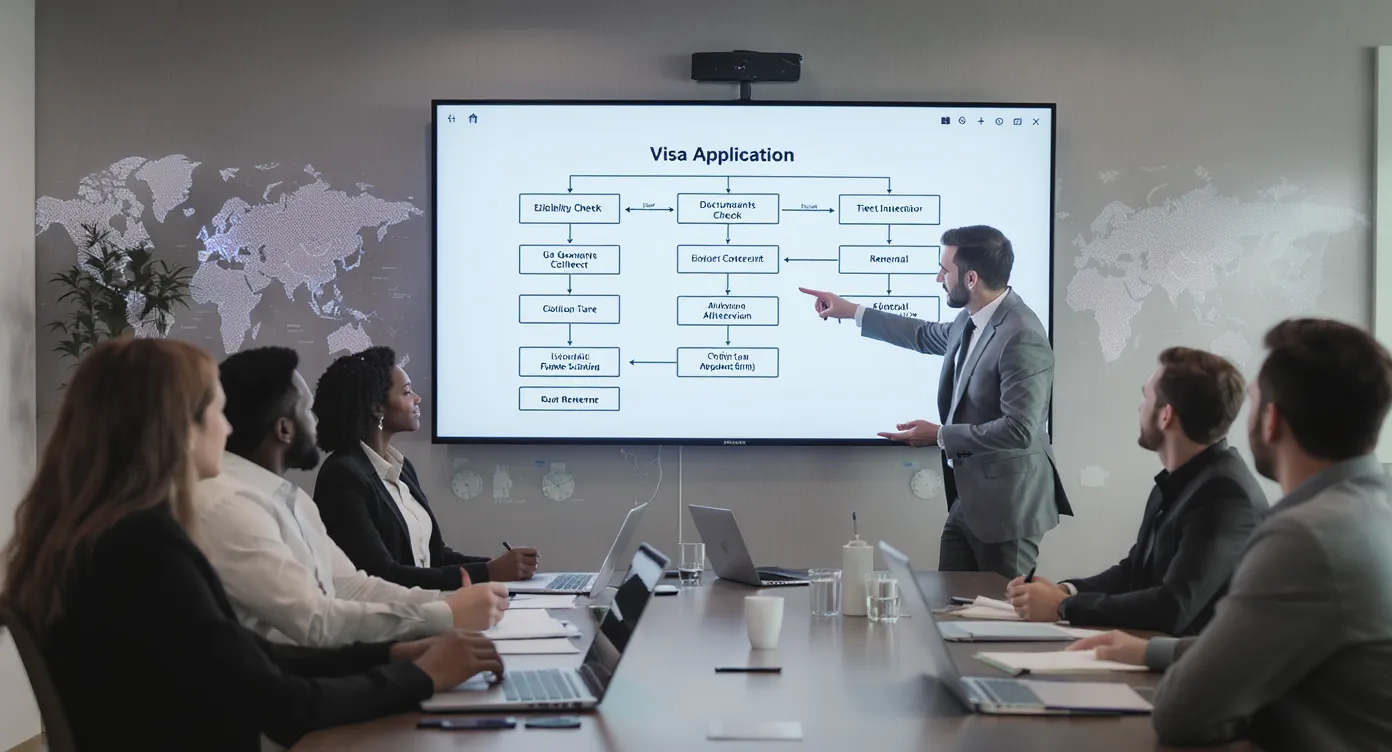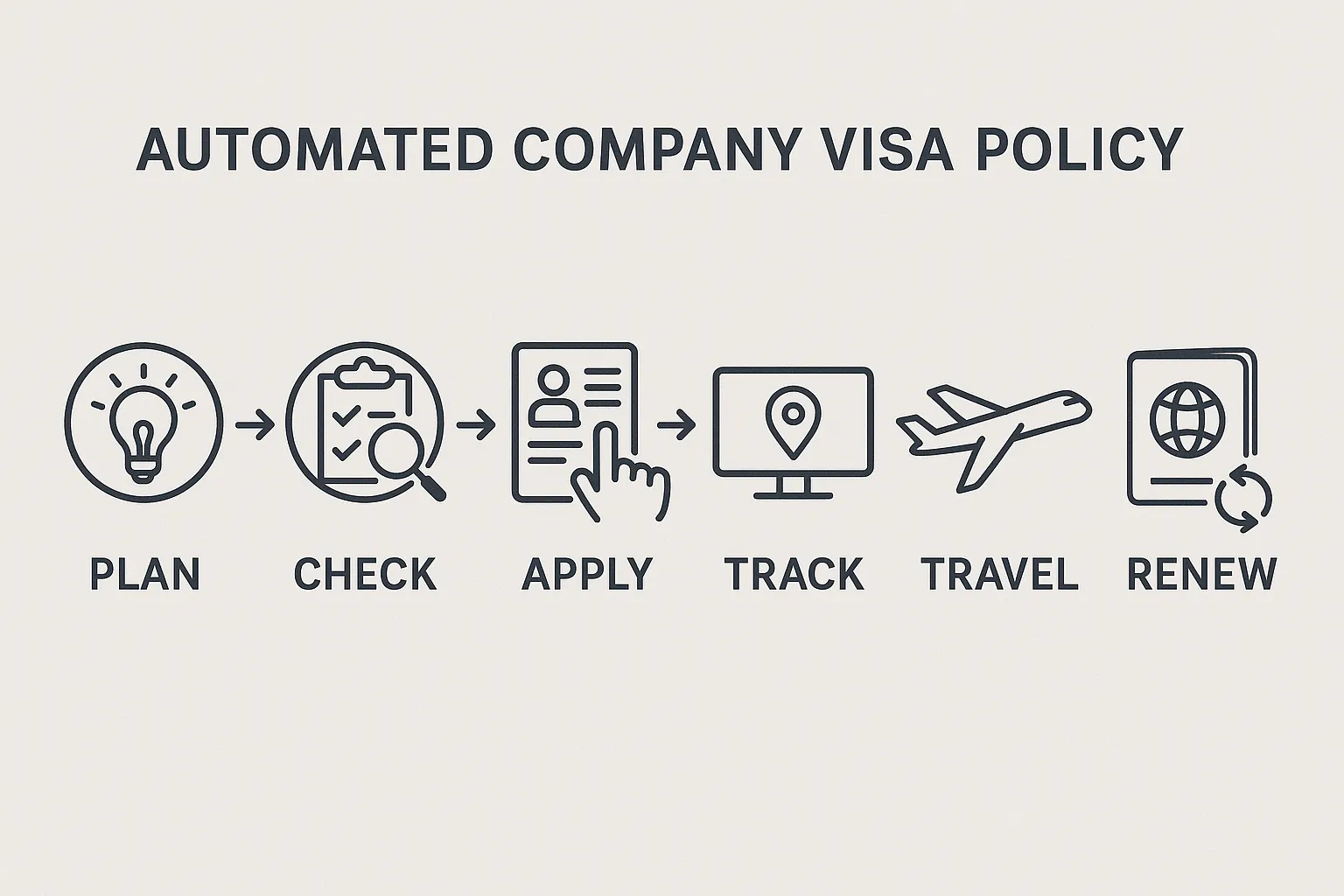Company Visa Policies: A Quick Guide

International assignments, last minute sales trips and cross-border conferences have become routine for many companies. Yet a single missing visa can derail an entire project, trigger fines, or leave an employee stranded at the gate. A clear, well-communicated company visa policy protects your people and your profit. If you have been tasked with writing or updating that policy, use this quick guide to cover the essentials and avoid expensive surprises.
What Is a Company Visa Policy?
A company visa policy is a set of written rules that define how your organisation manages entry permits, work authorisations and residence documents for employees who travel or relocate internationally. It typically sits alongside your travel and mobility policies and answers four core questions:
- Who is eligible for company-sponsored visas or permits?
- Who does what at every step of the application process?
- Which costs the company covers and which costs the traveller covers?
- How compliance and records are maintained for audits, renewals and duty of care.
Why Your Business Needs One
- Legal compliance and risk mitigation. Immigration penalties can reach tens of thousands of dollars per traveller, according to the U.S. Department of Labor and similar authorities worldwide.
- Employee experience. Delays cause stress and lost productivity; a clear policy sets expectations and reduces last-minute scrambles.
- Cost control. Standardising fees, approvals and preferred suppliers prevents hidden surcharges and duplicate payments.
- Data security. Centralising passport and personal data in secure platforms limits exposure to fraud or breaches.
- Employer brand. Transparent mobility support signals that the company values global career paths and worker well-being.
Key Components to Include
| Component | Purpose | Practical Tips |
|---|---|---|
| Eligibility rules | Define which trips and employee groups qualify for company assistance | Cover business travel, long-term assignments, dependents, interns and contractors separately |
| Roles and responsibilities | Avoid confusion about who gathers documents, pays fees and tracks deadlines | Use a RACI matrix (Responsible, Accountable, Consulted, Informed) |
| Application workflow | Provide a step-by-step timeline from pre-travel approval to arrival | Map to HRIS or travel booking triggers so visas start early |
| Documentation standards | List required scans, file types and photo specifications | Link to an online checklist to reduce back-and-forth |
| Cost coverage and recharge | State what the company reimburses (government fees, shipping, legal advice) | Specify cost centres or project codes for charge-backs |
| Data protection & storage | Comply with GDPR, HIPAA, PDPA or local rules | Encrypt PII, purge expired data, audit vendor security |
| Renewal & extension rules | Prevent overstays that can harm corporate reputations | Schedule automated reminders 90, 60 and 30 days before expiry |
| Exception process | Handle urgent trips or atypical scenarios without chaos | Create a fast-track escalation contact list |

Common Pitfalls (and How to Avoid Them)
- Late applications – Bookings happen before eligibility checks, leaving no time for consulate processing. Fix: integrate a real-time rules engine at the point of booking.
- Inconsistent cost handling – Teams in different countries pay different fees, breeding grievances. Fix: publish a single reimbursement table in local currencies.
- Shadow travel – Employees add personal side trips that breach visa terms. Fix: require itinerary uploads and educate staff on permitted activities.
- Spreadsheet chaos – Tracking visas in spreadsheets risks version errors and lost renewals. Fix: move to a secure cloud dashboard with alerts.
- Data-privacy gaps – Scans are emailed without encryption. Fix: use a platform with end-to-end encryption and role-based access controls.
Best Practices for Streamlined Visa Management
1. Start with an Audit
List every country your workforce entered in the past 24 months, the visa types used and any incidents (denied boardings, fines, missed meetings). This baseline helps prioritise focus areas and measure improvement.
2. Align with Business Objectives
Tie visa support levels to revenue impact. For example, sales engineers closing multimillion-dollar deals may warrant premium processing, while short conference trips can use standard channels.
3. Automate Eligibility Checks Early
Embedding a rules API into your online booking tool flags visa or ETA needs before tickets are issued, giving HR and travellers more lead time. A 2025 Deloitte Mobility survey found that companies using automated checks cut urgent consulate visits by 43 percent.
4. Centralise Applications and Status Tracking
A single portal—whether a white-label web app or an API feeding your HRIS—keeps documents, receipts and approvals in one place. That reduces email chains and lets managers view real-time status dashboards.
5. Educate & Empower Employees
Publish micro-learning modules or quick reference cards that explain key rules (passport validity, biometrics, entry conditions) for top destinations. Training reduces submission errors and speeds approvals.
6. Build Renewal into Workforce Planning
Set automated reminders tied to assignment end dates and project milestones. Include renewal budgets in project P&Ls so managers do not scramble for funds later.

Where Technology Fits In
SimpleVisa’s platform was built for travel providers, yet the same infrastructure solves corporate challenges:
- Visa processing automation eliminates manual data entry and repetitive form filling.
- API integration slots into your travel booking or HRIS so eligibility checks happen instantly.
- White-label app offers employees a familiar branded experience while HR gains oversight.
- Custom data services surface live policy rules for more than 200 jurisdictions, keeping your handbook up to date without manual edits.
Using an automated solution also increases compliance audit readiness. Time-stamped logs, immutable document storage and granular permission settings simplify external reviews.
For a deeper dive into how automated solutions boost business-travel compliance, see our guide “Electronic Visa for Business Travel: What You Need to Know”.
Quick Implementation Roadmap
- Policy draft (Week 1-2) – Adapt the template above; involve Legal, HR, Finance and IT.
- Stakeholder review (Week 3) – Present to leadership, incorporate feedback.
- Select technology (Week 4-5) – Compare no-code, white-label or API options. Request a SimpleVisa demo to assess fit.
- Pilot (Week 6-10) – Roll out to one region or business unit; monitor approval rate, processing time and user feedback.
- Global rollout (Month 3-6) – Train employees, retire legacy spreadsheets, enforce usage via travel-booking policies.
- Continuous improvement – Review metrics quarterly, update policy when destinations add ETAs or eVisas.
Next Steps
A robust company visa policy is no longer a nice-to-have, it is a core compliance and talent-mobility asset. Gather your baseline data, map responsibilities and automate the heavy lifting. When your travellers spend less time on paperwork and more time on business, the whole organisation wins.
Ready to put your policy on autopilot? Book a 30-minute discovery call with SimpleVisa and learn how our API or white-label solutions can cut processing time, boost approval rates and turn compliance into a revenue opportunity.